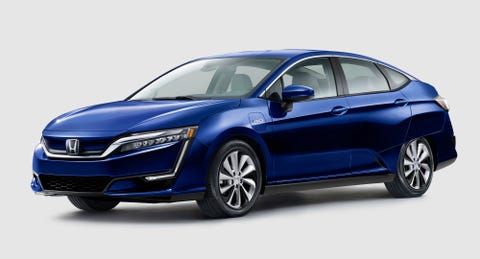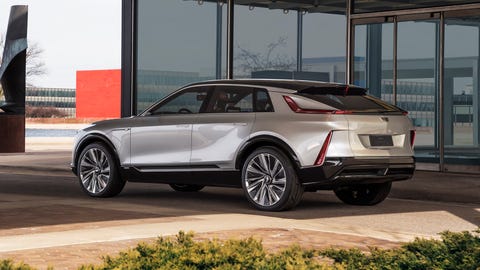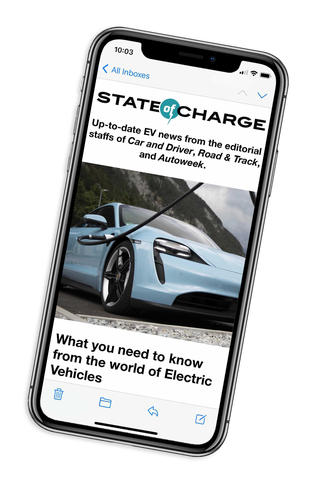- Honda plans to field two large EVs for the 2024 model year, using GM’s Ultium powertrain.
- The automaker plans for 40% of its North American offerings to be electric or hydrogen by 2030, with plans to field its own platforms after 2025.
- Honda’s hydrogen plans hinge on the expansion of hydrogen infrastructure, and could become less appealing as EV adoption progresses.
Honda may have been a hybrid pioneer along with Toyota, fielding the slippery Insight hatch in 1999, but just like Toyota it has waited on the sidelines to jump into the EV game, only throwing its hat in the ring relatively recently. And it hasn't made plans to offer its first truly mass-market EV, on sale in Europe right now, in North America.
Honda did offer an EV in the US for a brief moment, but odds are you've never seen it on the street. Honda began selling the Clarity Electric in Oregon and California starting in 2017, but withdrew it after it was panned for an 89-mile range. The hydrogen fuel-cell version of the Clarity, meanwhile, has been offered in southern California, but is perhaps an even narrower and costlier experiment at a time when the Tesla Model 3 is recording tens of thousands of sales worldwide each month.
It's fair to say that Honda's zero-emissions offerings to date have fallen a little flat. And it's also worth noting that when it comes to hybrids, the Honda Insight wallowed in the Toyota model's shadow for much of existence. An awkward first-gen Insight outing was followed by a Prius-shaped second-gen model that left after a few years (2010-'14) of lackluster sales. The Insight only came back to the market relatively recently, in 2019, this time as a Civic-style sedan.
Honda may get points for being an early player in the hybrid game, but points don't guarantee future success in different endeavors.
Earlier this week the automaker laid out its 20-year vision for electric models, setting out a gradual ramp-up to having 40% of its North American offerings be electric or fuel-cell by the year 2030. That's an ambitious target in itself, given how many vehicles Honda sells each year in the US, and just how slowly the share of battery-electric vehicles has been growing over the past decade, perpetually stuck between 2% and 3% nationally. To have one major automaker dial that up to almost half of its lineup over 10 years is more ambitious than it seems, especially given the fact that Honda plans to double that share five years later, aiming for 80% by 2035. Another five years after that, Honda expects 100% of its North American offerings to be battery-electric or fuel-cell.
The next EVs that we're scheduled to see from Honda in North America will only arrive for the 2024 model year, based on GM's Ultium battery-electric powertrain. The automaker indicated a few days ago that we're going to see two "large-sized" EV models at that point in time, one under the Acura brand and one under the Honda brand.
"Honda's aspirations to drop ICEs entirely by 2040 shouldn't come as much of a surprise as nearly every other automaker follows suit," Robby DeGraff, Industry Analyst at AutoPacific told Autoweek. "Honda's stuck to the hybrid approach for a few decades now and their first proper go at a dedicated EV, the Clarity Electric, was short-lived and delivered range numbers that were nowhere near competitive amongst today's EVs. Teaming up with GM to build its first of pair pure-electrics (one an Acura, the other a Honda) is a smart partnership that'll only lead to great results thanks to the Ultium platform. Look at the Cadillac Lyriq, that's a serious showstopper."
It sounds like the two models will share powertrains and platforms and be positioned above the CR-V, likely Pilot-sized, offering similar ranges and interior accommodations. This seems logical from the standpoint of saving development costs: a large but lower-priced Honda model, likely with three rows, and a more luxurious Acura model based on the same underpinnings, but priced higher.
Whether these two vehicles will be just the ticket remains to be seen, and with a scheduled arrival sometime in 2023 Honda will have plenty of time to prepare them for the market. Another way of looking at this timeline, however, is that 2024 model-year vehicles are still far on the horizon, while Toyota plans to offer two EVs in the States later this year. It also remains to be seen just how these two vehicles will be priced, and how varied the competition will be.
"Honda will need to execute its batch of EVs well in order for its base to bite, because at the moment consideration among new Honda owners remains increasingly strongest for traditional hybrids and petrol," DeGraff adds. "Our 2020 BRAND Study indicates that only 16 percent of new Accord owners and 17 percent of CR-V owners (the money maker) would consider an EV."
Honda won't be relying solely on GM's Ultium drivetrains, and plans to use its upcoming e:Architecture for other EVs headed stateside. But those models will arrive in 2025 or later, which means it's going to be a long time before we see any midsize sedan, hatch, or compact crossover Honda EV models.
While Honda's EV intentions are plainly spelled out, its hydrogen fuel-cell plans are a little more difficult to evaluate. That's because Honda is one of just a handful of players in the hydrogen field alongsideToyota, BMW, and Hyundai.
Hydrogen infrastructure, meanwhile, has made only very modest gains stateside.
"There are a lot of benefits going the hydrogen route with the pinnacle one being just how superbly clean they are," DeGraff says. "Hydrogen is an abundant resource and when the incentives stack up (like $15,000's worth of free fuel), they're are actually quite affordable… but infrastructure for FCVs is just as far behind in some places, if not non-existent, than the infrastructure needed for EVs. I do think it's wise for Honda to continue pursuing FCVs but there's a big issue that needs be addressed: the ability to refill them at home."
Just how big a part hydrogen will play in Honda's 2040 strategy remains to be seen, but like BMW, Toyota, and Hyundai, the automakers in this game are still at the mercy of hydrogen producers and station builders. Unless hydrogen infrastructure makes substantial leaps in the next 10 years (perhaps at the expense of attention paid to battery-electric models), it could be difficult to see this technology continuing to pose promise, especially if battery-electric vehicles experience a surge in adoption in the US.
"Unlike an EV or PHEV, which can be quickly plugged into an owner's garage overnight or at a public charging station, that's not the case for FCVs. Last I checked, California only has about 50 and then there's a minuscule scattering of them elsewhere across the US," DeGraff adds. "With the vast majority of FCVs roaming about in California, there are far more cars than refueling stations. I've seen photos a few times this year now on Twitter of FCVs lined up waiting at stations due to a hydrogen shortage. That's not going to win many shoppers over. A reliable way to refuel an FCV from the convenience of home is what will change the game and guarantee success."
Honda will need compelling EVs on the market at just the right time to avoid the fate of the Clarity Electric, and to come close to reaching that 40% zero-emissions goal by 2030. The adoption of hydrogen fuel-cell vehicles, on the other hand, will likely become an even tougher sell in the future as EV infrastructure rises.
Will hydrogen fuel-cell vehicles see significant growth in the next 10 years along with EVs, or will they remain a niche technology? Let us know in the comments below.
This content is created and maintained by a third party, and imported onto this page to help users provide their email addresses. You may be able to find more information about this and similar content at piano.io
The Link LonkApril 29, 2021 at 04:00PM
https://ift.tt/2Qz8RNG
Here’s Why Honda’s EV Plans Could Be a Challenge - Autoweek
https://ift.tt/38hkzRl
Honda




No comments:
Post a Comment